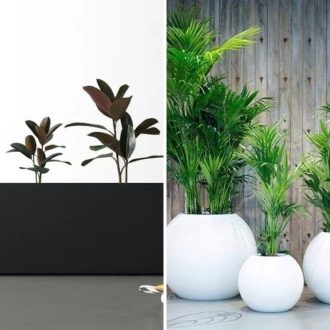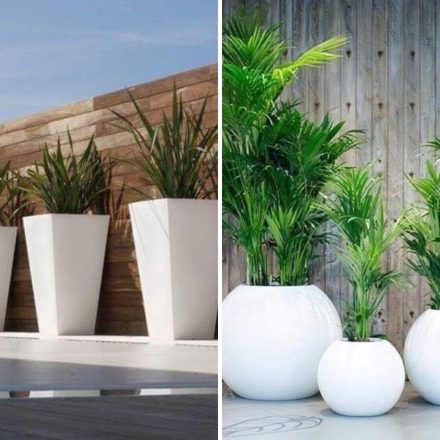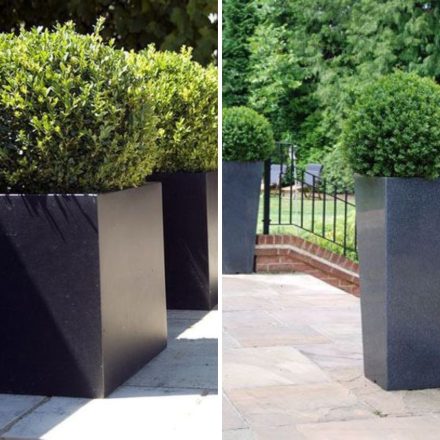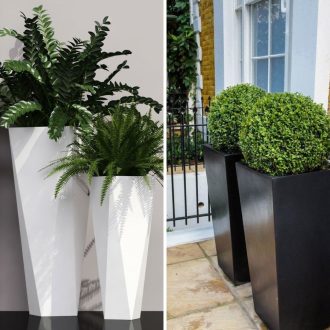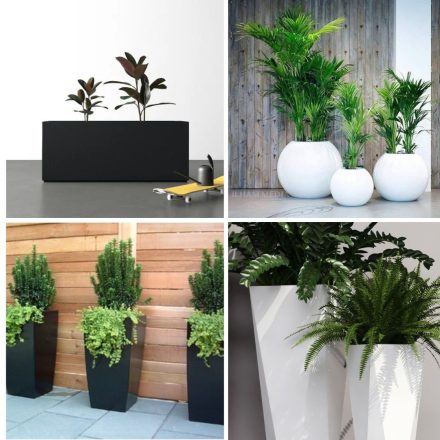fiberglass planters vs. traditional pots: which is right for you?

Introduction
Choosing the right planter is crucial for ensuring the health and aesthetic appeal of your plants. With the variety of options available today, it can be challenging to decide which type of planter best suits your needs. Two popular choices are fiberglass planters and traditional pots. Understanding the differences between these options can help you make an informed decision that benefits both your plants and your personal style.
Types of Planters
Fiberglass Planters
Fiberglass planters are crafted from a composite material that combines glass fibers and resin. This results in a lightweight yet durable product that can mimic the appearance of natural materials like stone or metal. Fiberglass planters come in various styles and finishes, including smooth, textured, matte, and glossy, making them suitable for modern and contemporary settings.

Traditional Pots
Traditional pots encompass a range of materials such as ceramic, terracotta, and plastic. Ceramic pots are known for their glazed finish and vibrant colors, while terracotta offers a rustic, earthy appearance. Plastic pots, on the other hand, are lightweight and often used for their affordability and practicality. Traditional pots are commonly used in gardens and patios, offering a classic look that complements a wide range of plants.
Advantages of Fiberglass Planters
Lightweight and Durable
Fiberglass planters are significantly lighter than traditional pots, making them easier to move and rearrange. Despite their lightweight nature, they are incredibly durable and resistant to cracks, chips, and breaks.
Weather Resistance
One of the standout features of fiberglass planters is their ability to withstand extreme weather conditions. They are non-porous, which prevents water absorption and reduces the risk of cracking during freezing temperatures.
Versatile Design Options
Fiberglass planters offer a wide range of design possibilities. They can be molded into various shapes and sizes and are available in multiple colors and finishes, allowing you to find the perfect match for your space.
Low Maintenance
Unlike some traditional pots that require regular sealing or glazing, fiberglass planters are low maintenance. Their non-porous surface makes them easy to clean and less prone to stains or discoloration.
Advantages of Traditional Pots
Disadvantages of Traditional Pots
Weight and Handling Issues
Materials like terracotta and ceramic can be heavy, making them difficult to move or rearrange, especially when filled with soil and plants.
Susceptibility to Weather Damage
Traditional pots, particularly those made from terracotta, can be susceptible to cracking in extreme weather conditions due to their porous nature.
Maintenance Requirements
Some traditional pots require regular maintenance, such as sealing or re-glazing, to maintain their appearance and durability.
Technical Specifications
Fiberglass Planter Construction Details
Fiberglass planters are made by layering fiberglass fibers with resin to create a strong, lightweight material. This process allows for a wide range of shapes and sizes, providing flexibility in design.
Traditional Pot Manufacturing Processes
Traditional pots are typically crafted from clay or other natural materials. The clay is shaped and then fired in a kiln to harden and strengthen the material. This process gives each pot its unique characteristics and appearance.
Applications
Indoor Use
Both fiberglass planters and traditional pots can be used indoors to enhance the aesthetic appeal of your home. Fiberglass planters are particularly popular for modern interiors due to their sleek design options.

Outdoor Landscaping
For outdoor use, fiberglass planters offer durability and weather resistance, making them ideal for patios and gardens. Traditional pots, with their classic charm, are also a popular choice for landscaping.
Commercial Spaces
In commercial settings, fiberglass planters are favored for their lightweight and versatile design, which allows for easy placement and rearrangement. They can be used to create attractive displays in offices, hotels, and restaurants.
Residential Gardens
Traditional pots are commonly used in residential gardens for their natural appearance and wide availability. They can complement a variety of plant types and garden styles.
Benefits for Plant Health
Moisture Control
Fiberglass planters have non-porous surfaces that prevent moisture loss, helping to maintain consistent soil moisture levels. Traditional pots, particularly those made from terracotta, allow for better moisture control through their breathable material.
Temperature Regulation
Both fiberglass and traditional pots can help regulate soil temperature, protecting plant roots from extreme heat or cold. Fiberglass planters are particularly effective in insulating roots from temperature fluctuations.
Plant Growth Support
The right planter can support healthy plant growth by providing adequate space for root expansion and ensuring proper drainage. Both fiberglass and traditional pots offer options to accommodate different plant sizes and needs.
Challenges and Limitations
Matching Planter Choice to Plant Type
Choosing the right planter involves considering the specific needs of your plants. Some plants may thrive better in traditional pots due to the breathability of materials like terracotta, while others may benefit from the moisture retention of fiberglass planters.
Potential for Root Binding
Both types of planters can lead to root binding if not appropriately sized. It’s essential to choose a planter with enough space for root growth to prevent stunted plant development.
Drainage Issues
Proper drainage is crucial for plant health, and both fiberglass and traditional pots should be equipped with drainage holes to prevent waterlogging and root rot.
Latest Innovations in Planters
Smart Planter Technology
Recent advancements in technology have led to the development of smart planters, which can monitor soil moisture levels, light exposure, and temperature, providing valuable insights for optimal plant care.
Sustainable Materials
Eco-friendly materials are becoming increasingly popular in planter design. Innovations include biodegradable pots and those made from recycled materials, reducing environmental impact.
Modular Design Systems
Modular planter systems allow for customizable configurations, making it easy to adapt to different spaces and plant arrangements. These systems offer flexibility and creativity in garden design.
Future Prospects
Trends in Planter Design and Materials
The future of planter design is leaning towards sustainable and eco-friendly options, with a focus on using recycled and biodegradable materials. Customizable and modular designs are also gaining popularity.
Innovations in Sustainable Practices
Planter manufacturers are exploring new ways to reduce environmental impact, such as using solar-powered production methods and incorporating sustainable materials into their products.
Market Growth Projections
The market for planters is expected to grow as more people embrace gardening and plant care as a hobby. This growth is driven by increased interest in indoor gardening and sustainable living practices.
Comparative Analysis
Cost Comparison
Fiberglass planters are generally more expensive than traditional pots due to their durability and design flexibility. However, they may offer long-term savings through reduced maintenance and replacement costs.
Durability and Longevity
Fiberglass planters are known for their durability and resistance to weather damage, making them a long-lasting option. Traditional pots may require more frequent replacement due to their susceptibility to cracking and wear.
Aesthetic Differences
The choice between fiberglass and traditional pots often comes down to personal preference. Fiberglass planters offer modern, sleek designs, while traditional pots provide a classic, timeless appeal.
User Guides and Tutorials
Choosing the Right Planter for Your Needs
When selecting a planter, consider factors such as the plant type, location, and desired aesthetic. Assess the size and weight of the planter to ensure it fits your space and needs.

Planting Techniques for Fiberglass and Traditional Pots
For fiberglass planters, ensure proper drainage by adding a layer of gravel or stones at the bottom. When using traditional pots, consider the breathability of materials like terracotta and adjust watering accordingly.
Maintenance Tips
Fiberglass planters require minimal maintenance; occasional cleaning with a damp cloth can keep them looking new. Traditional pots may need sealing or re-glazing to maintain their appearance and prevent water damage.
FAQ
Common Questions About Fiberglass Planters
- Are fiberglass planters safe for plants? Fiberglass planters are safe for plants and provide a non-toxic environment for growth.
- How do I clean fiberglass planters? Use a damp cloth to wipe down the surface, removing dirt and debris. For stubborn stains, a mild detergent can be used.
- Do fiberglass planters need drainage holes? Yes, adding drainage holes is essential to prevent waterlogging and ensure healthy plant growth.
Common Questions About Traditional Pots
- Can traditional pots be used indoors? Yes, traditional pots are suitable for indoor use, provided they have adequate drainage.
- How do I prevent terracotta pots from cracking? Protect terracotta pots from extreme temperatures and consider sealing them to reduce moisture absorption.
- Are ceramic pots good for all plants? Ceramic pots are versatile and can accommodate various plants, but consider the specific needs of each plant type.
Tips for Planter Maintenance
- Ensure proper drainage: Both fiberglass and traditional pots should have drainage holes to prevent waterlogging.
- Choose the right size: Select a planter that provides enough space for root growth to avoid root binding.
- Regular cleaning: Keep planters clean to maintain their appearance and promote plant health.
In conclusion, understanding the differences between fiberglass planters and traditional pots can help you make an informed decision that enhances your gardening experience. Whether you prioritize durability, aesthetics, or sustainability, there’s a planter option that meets your needs and supports the health of your plants.
Conclusion
Both fiberglass planters and traditional pots offer unique benefits and challenges. Fiberglass planters provide durability, lightweight design, and weather resistance, making them ideal for modern settings. Traditional pots offer classic charm and natural material benefits, appealing to those who appreciate timeless aesthetics. Ultimately, the right choice depends on your specific needs, preferences, and the plants you intend to grow.
